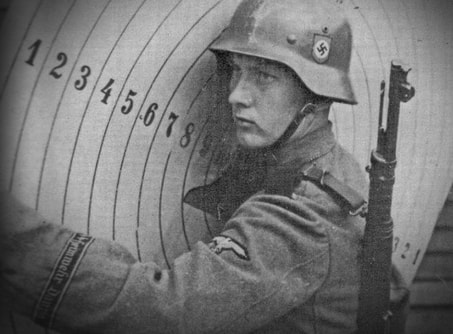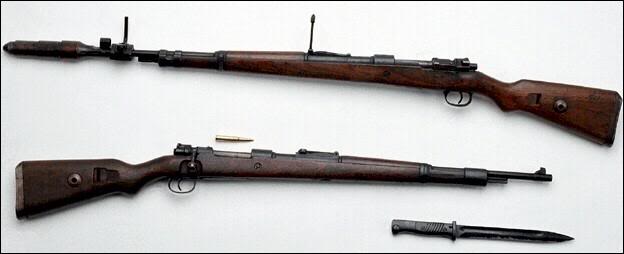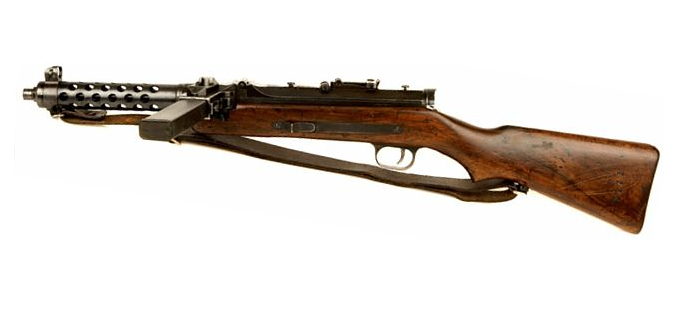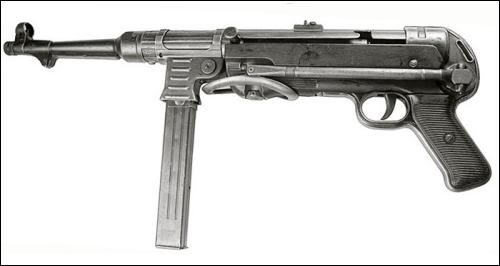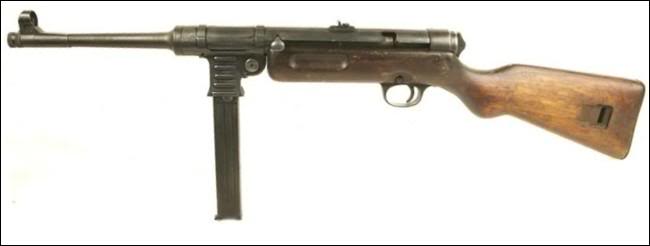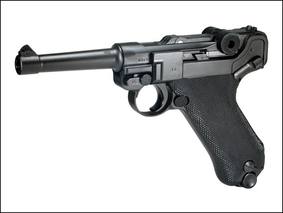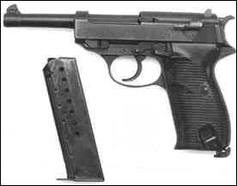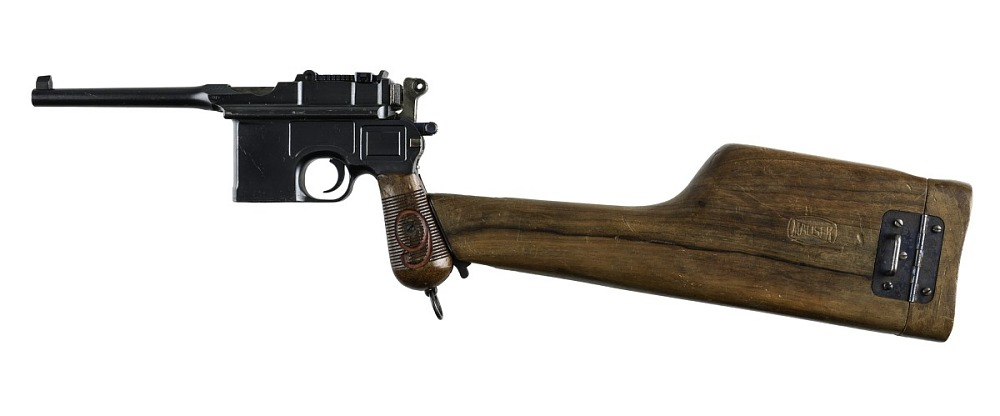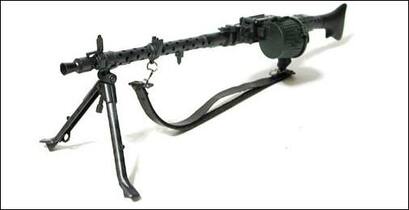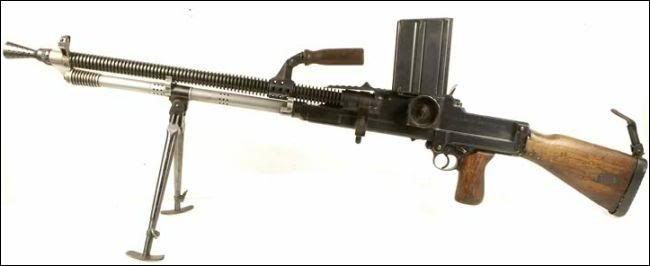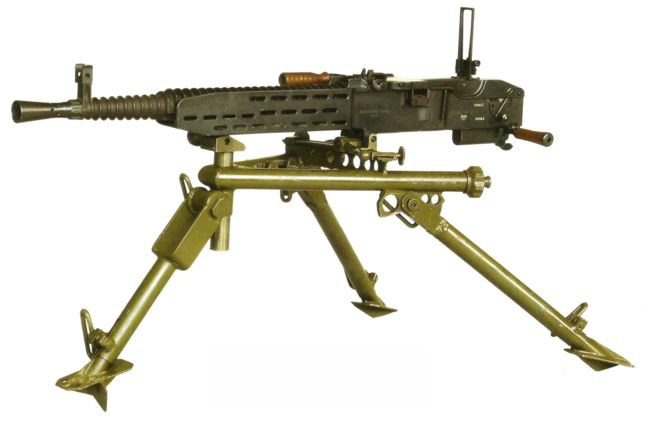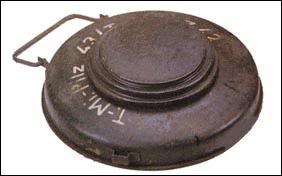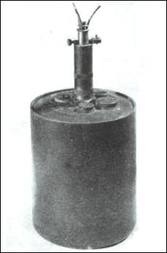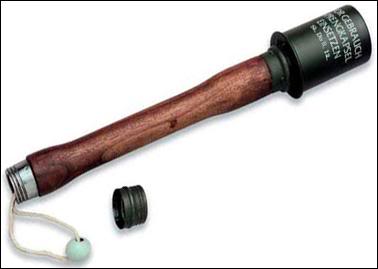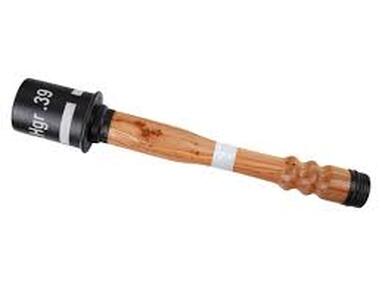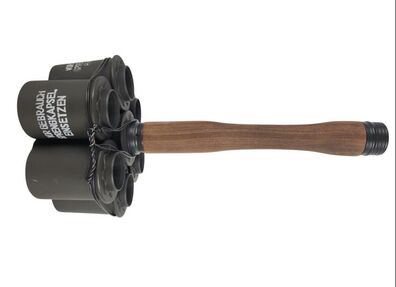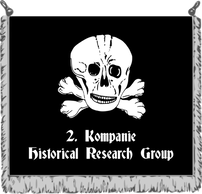Weapons of 2. Kompanie
|
Mauser Karabiner 98k
|
Mauser Karabiner 98k
The standard German Karabiner 98K became the final improved version of the 1898 Mauser. Adopted in 1935 for the Wehrmacht, nearly 11 million copies were made by the end of the war. The Mauser 98K is a bolt-operated, magazine fed shoulder weapon. The internal magazine holds five rounds of 7.92 mm rifle ammunition. Maximum range is approximately 3000 yards with an effective range of 800 yards. The weapon weighs approximately 9 lbs. loaded with an overall length of 43.6 inches. |
|
Machinepistole-28
|
Machinepistole-28
M.P.28.II submachine gun is blowback operated, selective-fire weapon that fired from open bolt. Tubular receiver was attached to the front of the wooden stock, and could be pivoted barrel down for maintenance and disassembly. Magazines are inserted from the left side, ejection is to the right. In the early years of the war, the Waffen-SS was equipped mainly with Mp28’s, Mp34’s and ERMA Submachine-guns, as the main allotment of Mp40’s were all delivered to the Wehrmacht. |
|
Machinepistole-34
|
Machinepistole-34
The MP34 was manufactured by Steyr0Solothurn as the S1-100, and was used in large numbers by the Austrian Army, and various units of the Wehrmacht in the early years of the year. Considered out of date with the newly made MP-38/40, the MP-34 was designated for rear-line troops. With the SSTK only recieving second-hand and lower quality weapons, the MP-34 saw heavy use in the division through 1942. Eventually, like the MP-28 and the ERMA, the MP-34 would be replaced by the iconic MP-40. |
|
Machinepistole-35 "ERMA"
|
Machinepistole-35 "ERMA"
The ERMA EMP, or MP-35, as it was known in the German military, was produced by Erma and designed by Heinrich Vollmer. Roughly 10,000 were made between 1931 and 1938. The ERMA was unique among the wood-stocked sub-machineguns in that it was equipped with a foregrip, a modern feature not often seen. An early sub-machinegun, it saw use in the war in Spain, and was also available on the private market, which was how it made its way into the hands of the SSTK. ERMA MP-35's were seen in large numbers until the division was refit in 1942. |
|
Machinepistole-40
|
Machinepistole-40
This main production machine pistol was developed from the MP38, an earlier model designed for issue to Fallschirmjäger troops and still used throughout the war. Produced by ERMA (not Schmeisser as commonly believed), the MP40 was constructed with a combination stamped, welded, and formed parts (plastic and metal) The magazines were ribbed for strength and held 32 rounds of 9mm ammunition. The weapon is blowback operated and has a cyclic rate of fire of 500 rounds per minute, and a practical rate of 180 rounds per minute. The weapon weighs 9 lbs. without a magazine and the overall length is 33 1/2 inches. |
|
Machinepistole-41
|
Machinepistole-41
The MP41, manufactured by Haenel, The MP41, manufactured by Haenel, was used by Germany's paramilitary police units, which had long been armed with wooden stocked MP28 's. The wooden stocks allowed the butts to be used as clubs in riot situations. The MP41 was identical to the MP40 in all respects other than the difference in stocks. Was used by Germany's paramilitary police units, which had long been armed with wooden stocked MP28 's. However, photographic evidence has shown that numbers of these reached front line units, mainly with officers, some of which serving with SS-Totenkopf. |
|
Luger Pistole, Model 1908 (P08)
|
Luger Pistole, Model 1908 (P08)
The 1-lb./14 oz. handgun was first issued in WWI and retained during the Wehrmacht's expansion due to weapons shortages. The P08 chambered a 9mm round from a detachable 8 round magazine. The system of operation revolved around a recoil and toggle joint. Although preferred by officers, the P08 did not prove to be reliable under combat conditions and was replaced by the Walther P38. The overall length of the barrel is 4 1/2 inches, and weighs 2 pounds. It's effective combat range is around 32 yards. |
|
Walther Pistole, Model 1938 (P38)
|
Walther Pistole, Model 1938 (P38)
In 1938, the Wehrmacht had begun to adopt the P38 as a replacement to the P08. It weighs 2-lbs./1.5 oz. and has an 8 round detachable magazine. Double action capability is due to its recoil operating system. The P38 was well accepted by the Wehrmacht and Waffen-SS due to its ability to operate in all types of adverse conditions. The P38 chambered a 9mm round. The overall length of the barrel is 4 3/4 inches. It's overall effective range was comparable to the P08. |
|
Mauser C96 "Broomhandle"
|
Mauser C96 "Broomhandle"
The Mauser C96 was a pistol that was magazine fed, but could also be loaded with stripper clips. It was manufactured from 1896 through 1937. The C96 was produced in semi-automatic, as well as fully automatic, and was fitted with a wooden stock that also served as a holster for the pistol. The C96 saw extensive use in Span and China. The Mauser "Broomhandle" was available on the private market, which was how it made its way into the hands of the SSTK. |
|
Machinegewehr-34
|
Machinegewehr-34
Designed by Mauser from the Swiss MG30 as the first general purpose machine gun. It could be carried by one man for general infantry assault roles or mounted on a tripod for long range precision firing, or mounted on a AA mount for anti-aircraft roles. The 26 lb./11 oz. recoil operated 7.92mm belt-fed machine gun fired 850 rounds per minute. The close tolerance of parts made the MG34 vulnerable to stoppage under combat conditions. The overall length is 48 inches. The weight with bipod is 26 1/2 lbs., and weight with tripod is 42 lbs. The practical rate of fire as a LMG is 100-200 rounds per minute, and as a HMG 300 rounds per minute. The effective range as a LMG is 600-800 yards, and as a HMG is 2000-2500 yards. |
|
Machinegewehr-26 (ZB-26)
|
Machinegewehr-26 (ZB-26)
The Wehrmacht soon adopted the ZB-26 after the occupation of Czechoslovakia, renaming it the MG 26(t); it was used in the same role as the MG-34, as a light machine gun. In the opening phases of World War II, the ZB-26 in 7.92 mm Mauser caliber was used in large numbers by elements of the German Waffen-SS, who at first did not have full access to standard Wehrmacht supply channels. Photo evidence shows that SS-Totenkopf received a very large amount of these machine guns, and used them from France all the way through Russia until they were exchanged for MG-34’s. |
|
Machinegewehr-37 (ZB-37 / 53)
|
Machinegewehr-37 (ZB-37 / 53)
The ZB-53 was a Czech heavy machine gun used by various armies during WWII. It was produced by BRNO. After the annecation of Czechloslovakia in 1938, large numbers were put into the reserves of the German Army where it was known as the TK vz. 37, or ZB-37. When SSTK rolled into France, their Heavy Machine Gun Companies had not been equipped with the tripod mounted MG-34's and instead were issued ZB-37s. It was the ZB-37 that was used at the infamous Le Paradis Massacre, which might explain why British Private Pooley was unable to identify the type of gun used. |
|
Tellermine-35
|
Tellermine-35
The Tellermine 35 (T.Mi.35) was a German metal-cased anti-tank mine used extensively during the Second World War. The mine's case is made of sheet steel, and has a slightly convex pressure plate on the top surface with a central fuze well. Two secondary fuze wells are located on the side and bottom of the mine for anti-handling devices. These were used extensively by Max Seela's "tank hunting" squads during the Demjansk Kessel, when SSTK severely lacked sufficient armor and anti-tank guns and had to resort to using tellermines and bundle grenades. |
|
Tellermine-43
|
Tellermine-43
The Tellermine 43 was a German circular steel cased anti-tank blast mine used during the Second World War. It is a simplified version of the Tellermine 42, which enabled simpler production techniques. Between March 1943 and the end of the war, over 3.6 million Tellermine 43s were produced by Germany. Copies of the mine were produced by several countries including Denmark (M/47), France (Model 1948) and Yugoslavia (TMM-1). |
|
SMi-35 “S” Mine
|
SMi-35 “S” Mine
The German S-mine (Schrapnellmine in German), also known as the Bouncing Betty. When triggered, these mines launch into the air and then detonate at about waist height. The explosion projects a lethal shower of steel balls and steel fragments in all directions. It was designed to be used in open areas to attack unshielded infantry. Two versions were produced, designated by the year of their first production: the SMi-35 and SMi-44. There are only minor differences between the two models. |
|
Stielhandgranate Model 1939
|
Stielhandgranate Model 1939
High explosive stick grenade, the grenade consists of a hollow wooden handle and a thin sheet medal head containing the bursting charge. A double length of cord connects a porcelain bead at the lower end of the handle to a friction igniter and detonator assembly screwed on the head of the grenade. The surface of the sleeve may be either smooth or divided by serration's to assist fragmentation. Model 43 is similar to the previous model except it has a solid handle, a blue-capped pull igniter, and a greater weight of bursting charge. |
|
Nebelhandgranate Model 1939
|
Nebelhandgranate Model 1939
In 1939 the Stielhandgranate design was modified to create the Nebelhandgranate "smoke hand grenade". Smoke was used for masking protection from enemy fire and signaling. There were two variants, the Nb.Hgr.39 and the Nb.Hgr.39b The "b" version differs in that the handle, has raised ridges and an additional white band to aid in identification at night. The Nb.39 pot contained a mixture of zinc powder and hexachlorethane which produced a smoke cloud upon ignition. Holes in the bottom of the head provided an escape path for the smoke as it burned. |
|
Geballte Ladung
|
Geballte Ladung
Although the Model 24 stick grenades were not individually very effective against armored vehicles and fortifications, the grenade could be used in an improvised "bundle" style with another six explosive heads (without their sticks) wired around the central stick grenade. These were known as Geballte Ladung (literally "baled charge" or "concentrated charge"). These Geballte ladung were used for demolition work rather than anti personnel use. They were also capable of blowing off tracks from an armored vehicle though not of penetrating anything more than very thin amour. |
